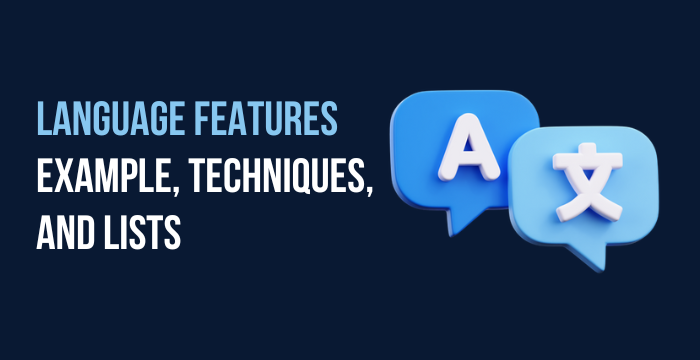
What are Language Features?
The English language uses special features and unique attributes to communicate various types of information. This makes the English language one of the world's most beautiful languages. The knowledge of different types of language features and literary devices is essential for a literature student as it helps create high-quality literary work. More knowledge of English language functions is also essential in examining the literature work by other authors and helps identify teh writing approach used by them. The knowledge of English language features is also essential as it helps create different types of reports, letters and documents using your unique ideas and concepts. The following blog will be beneficial in providing information regarding the different types of English language features that will help create high-quality English literature papers.
Benefits of Using Language Features:
Language is one of the essential communication elements that evolved with history. Each language has its style, tone, and linguistic symbols and features. Therefore, to improve the quality of the language during writing and speaking, it is essential to follow a particular language's styles, tones and features. Language features are essential as they help improve the student's reading and writing skills. Some of the other significant features of using language features are
- Language features are essential as they help the writers and readers understand the information they read or write.
- Language features are also crucial for the writers as they help influence the readers' minds and help them make decisions.
- Language features are also crucial as they help prove definite texts used while writing or speaking.
- The language provides an efficient tool for the writer or speaker to provide information regarding some specific incident, such as an accident product or event.
Essential Language Techniques for English:
Language techniques are those phrases and words used in the body of the content, which help in showcasing the theme of the content. Language techniques are essential as they help attract the audience's attention and make the literature more enjoyable for the readers. Language techniques are also essential as they help increase the writer's writing skills.
Examples of language techniques are:
Colloquial language, figurative language, metaphor, alliteration, consonance, smile, etc. These language techniques are essential as they help increase the quality of the information provided in the content by the writer.
1. Figurative language
This type of technique is generally used in stories and poems. The meaning of the words is different from what we use in our daily lives. This type of language is beneficial in attracting the writer's attention as it makes the content enjoyable. Oxomeorin, metaphor, hyperbole and smile are typical examples of figurative language.
2. Dialogue
It refers to the communication process for more individuals and plays a significant role in drama. Dialogues generally take into account different types of lunges and statements.
3. Colloquial language
The informal words and phrases used in the language form part of colloquial language. Some of the frequently used colloquial languages in communication are relaxed, chill pill, etc.
4. Alliteration
In this type of language, the first letter of a word is repeated and continues alternatively in a statement or sentence.
Examples of language features
- Quantitative
- Demonstrative
- Possessive
- Interrogative
- Distributive
- Articles
- Adverb
- Alliteration
- Simile
- Emotive Language
- Active Listening
- Adjective
- Positive Adjective
- Comparative Adjective
- Superlative Adjective
- Descriptive
5. Active language
Active listening is integral to communication and helps facilitate communication between two persons efficiently and effectively. The active listening function is used mainly in performing seminars, counselling, sessions, etc. and promotes a practical understanding of the content shared between the receivers and the senders.
6. Adjective
Adjectives help in providing information about the quality of the noun used in the topic. For instance, Tina is an intelligent girl. Here, intelligent is the adjective of the noun, which provides information that tine is intelligent.
7. Quantitative
Quantitative features help provide information by reading the quantity of an object mentioned in the content. It helps in quantifying different objects present in the content.
8. Interrogative
This type of feature is used in text to ask a question in the text. For instance, what is the name of this place?
9. Alliteration
The feature is to use the word's first letter in every different phrase. For example, Lip, Lock, Lion, etc.
10. Smile
This feature in the English language helps compare different objects in the content. For instance, as beautiful as. These types of features help in comparing similarities and similarities in the content.
11. Metaphor
This technique provides information regarding any object, person or situation differently.
12. Emotive language
This feature is essential to English as it helps the writer express different emotions. For instance, emotive language expresses the writer's feelings when a person gets extreme happiness.
Language techniques in English
Language techniques are essential as they help understand and write different types of stories and poems more effectively. The use of language technique is very beneficial as they help attract the audience and increases their focus on the essential elements of the story or poem. Some of the critical techniques used in the English language are
1. Allusion
The writer uses this technique to indirectly refer to a person or object in the story or poem. In this technique, the writer provides only partial information regarding the subject or object and expects that the reader has the required knowledge to understand the person referring to and relate the information provided.
2. Idiom technique
In this technique, the writer uses two more words to deliver more information than a single word. The use of this technique is constructive for the writer as it helps in improving the quality of the writer and also helps in making the writer more productive.
3. Ambiguity technique
This creates confusion in the readers' minds and provides two options to select. It results in creating confusion regarding the information provided in the context.
4. Imaginary technique
It is a commonly used decorative technique used in the essay to create an image in the essay in the minds of the readers. It helps connect with the information provided in the essay, which helps improve the quality of the information provided to the readers.


